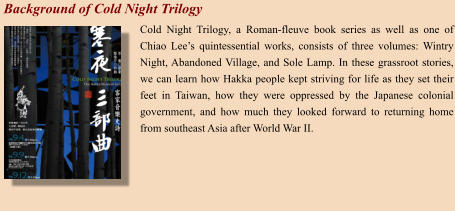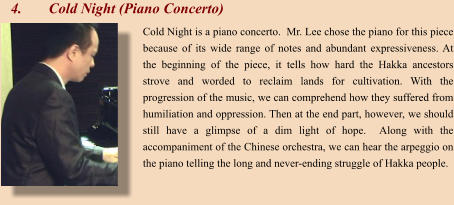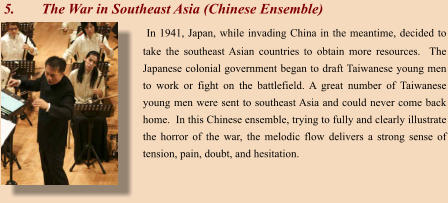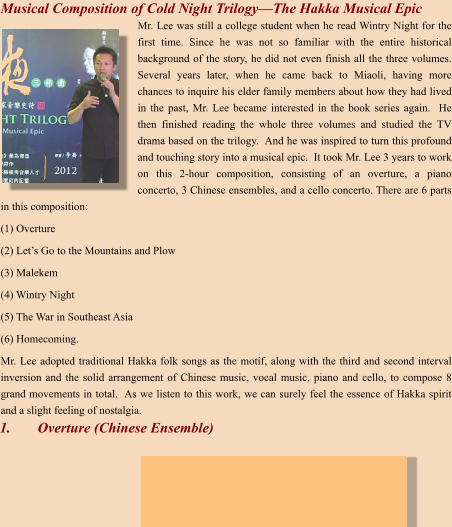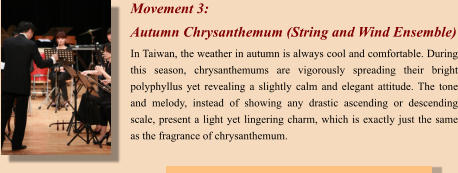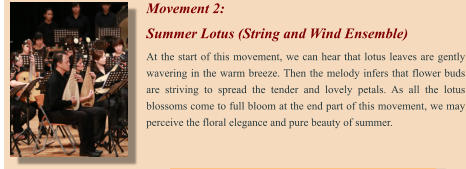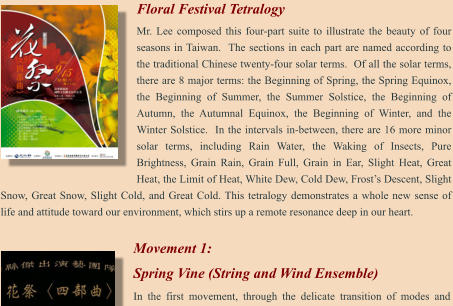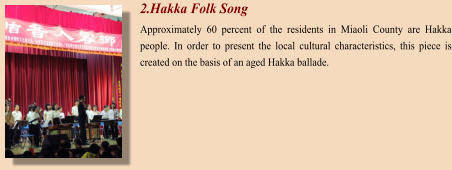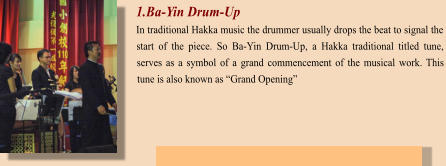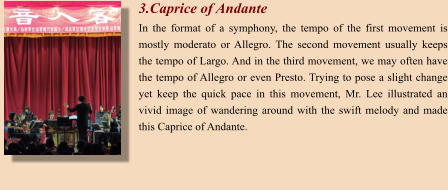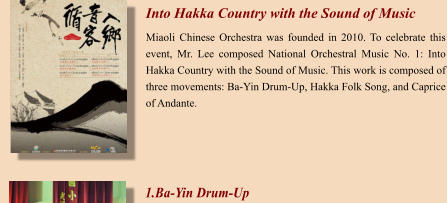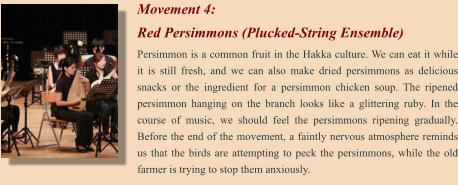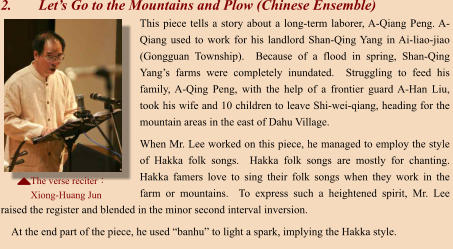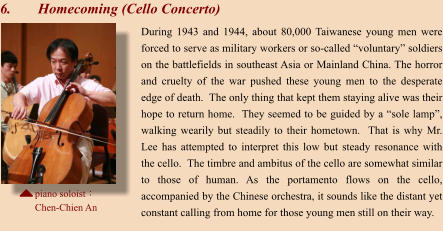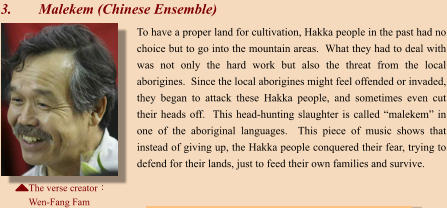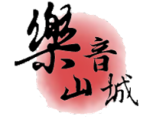Background of Cold Night Trilogy
Cold
Night
Trilogy,
a
Roman-fleuve
book
series
as
well
as
one
of
Chiao
Lee’s
quintessential
works,
consists
of
three
volumes:
Wintry
Night,
Abandoned
Village,
and
Sole
Lamp.
In
these
grassroot
stories,
we
can
learn
how
Hakka
people
kept
striving
for
life
as
they
set
their
feet
in
Taiwan,
how
they
were
oppressed
by
the
Japanese
colonial
government,
and
how
much
they
looked
forward
to
returning
home
from southeast Asia after World War II.
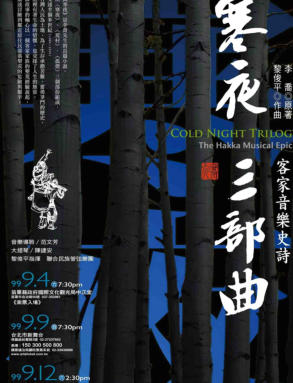
1.
Overture (Chinese Ensemble)
2.
Let’s Go to the Mountains and Plow (Chinese Ensemble)
This
piece
tells
a
story
about
a
long-term
laborer,
A-Qiang
Peng.
A-
Qiang
used
to
work
for
his
landlord
Shan-Qing
Yang
in
Ai-liao-jiao
(Gongguan
Township).
Because
of
a
flood
in
spring,
Shan-Qing
Yang’s
farms
were
completely
inundated.
Struggling
to
feed
his
family,
A-Qing
Peng,
with
the
help
of
a
frontier
guard
A-Han
Liu,
took
his
wife
and
10
children
to
leave
Shi-wei-qiang,
heading
for
the
mountain areas in the east of Dahu Village.
When
Mr.
Lee
worked
on
this
piece,
he
managed
to
employ
the
style
of
Hakka
folk
songs.
Hakka
folk
songs
are
mostly
for
chanting.
Hakka
famers
love
to
sing
their
folk
songs
when
they
work
in
the
farm
or
mountains.
To
express
such
a
heightened
spirit,
Mr.
Lee
raised
the
register
and
blended
in
the
minor
second
interval
inversion.
At
the
end
part
of
the
piece,
he
used
“banhu”
to
light
a
spark,
imply
-
ing the Hakka style.
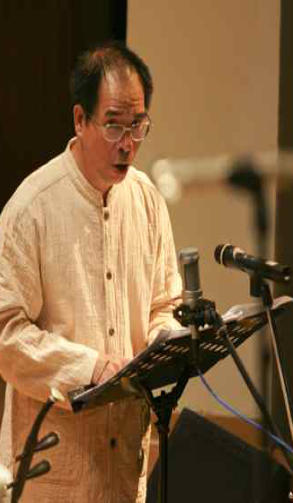
3.
Malekem (Chinese Ensemble)
To
have
a
proper
land
for
cultivation,
Hakka
people
in
the
past
had
no
choice
but
to
go
into
the
mountain
areas.
What
they
had
to
deal
with
was
not
only
the
hard
work
but
also
the
threat
from
the
local
aborig
-
ines.
Since
the
local
aborigines
might
feel
offended
or
invaded,
they
began
to
attack
these
Hakka
people,
and
sometimes
even
cut
their
heads
off.
This
head-hunting
slaughter
is
called
“malekem”
in
one
of
the
aboriginal
languages.
This
piece
of
music
shows
that
instead
of
giving
up,
the
Hakka
people
conquered
their
fear,
trying
to
defend
for
their lands, just to feed their own families and survive.
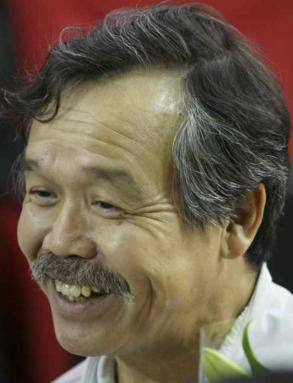
4.
Cold Night (Piano Concerto)
Cold
Night
is
a
piano
concerto.
Mr.
Lee
chose
the
piano
for
this
piece
because
of
its
wide
range
of
notes
and
abundant
expressive
-
ness.
At
the
beginning
of
the
piece,
it
tells
how
hard
the
Hakka
an
-
cestors
strove
and
worded
to
reclaim
lands
for
cultivation.
With
the
progression
of
the
music,
we
can
comprehend
how
they
suffered
from
humiliation
and
oppression.
Then
at
the
end
part,
however,
we
should
still
have
a
glimpse
of
a
dim
light
of
hope.
Along
with
the
accompaniment
of
the
Chinese
orchestra,
we
can
hear
the
arpeggio
on
the
piano
telling
the
long
and
never-ending
struggle
of
Hakka
people.

5.
The War in Southeast Asia (Chinese Ensemble)
In
1941,
Japan,
while
invading
China
in
the
meantime,
decided
to
take
the
southeast
Asian
countries
to
obtain
more
resources.
The
Japanese
colonial
government
began
to
draft
Taiwanese
young
men
to
work
or
fight
on
the
battlefield.
A
great
number
of
Taiwanese
young
men
were
sent
to
southeast
Asia
and
could
never
come
back
home.
In
this
Chinese
ensemble,
trying
to
fully
and
clearly
illustrate
the
horror
of
the
war,
the
melodic
flow
delivers
a
strong
sense
of
ten
-
sion, pain, doubt, and hesitation.
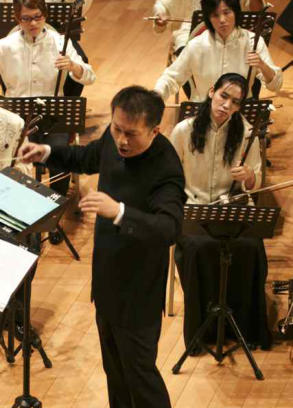
6.
Homecoming (Cello Concerto)
During
1943
and
1944,
about
80,000
Taiwanese
young
men
were
forced
to
serve
as
military
workers
or
so-called
“voluntary”
soldiers
on
the
battlefields
in
southeast
Asia
or
Mainland
China.
The
horror
and
cruelty
of
the
war
pushed
these
young
men
to
the
desperate
edge
of
death.
The
only
thing
that
kept
them
staying
alive
was
their
hope
to
return
home.
They
seemed
to
be
guided
by
a
“sole
lamp”,
walking
wearily
but
steadily
to
their
hometown.
That
is
why
Mr.
Lee
has
attempted
to
interpret
this
low
but
steady
resonance
with
the
cello.
The
timbre
and
ambitus
of
the
cello
are
somewhat
similar
to
those
of
human.
As
the
portamento
flows
on
the
cello,
accompanied
by
the
Chinese
orchestra,
it
sounds
like
the
distant
yet
constant
call
-
ing from home for those young men still on their way.
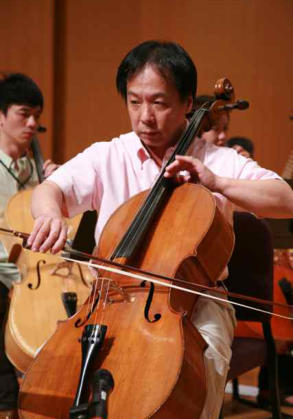
Musical Composition of Cold Night Trilogy—The Hakka Musical Epic
Mr.
Lee
was
still
a
college
student
when
he
read
Wintry
Night
for
the
first
time.
Since
he
was
not
so
familiar
with
the
entire
historical
back
-
ground
of
the
story,
he
did
not
even
finish
all
the
three
volumes.
Several
years
later,
when
he
came
back
to
Miaoli,
having
more
chances
to
inquire
his
elder
family
members
about
how
they
had
lived
in
the
past,
Mr.
Lee
became
interested
in
the
book
series
again.
He
then
finished
reading
the
whole
three
volumes
and
studied
the
TV
drama
based
on
the
trilogy.
And
he
was
inspired
to
turn
this
profound
and
touching
story
into
a
musical
epic.
It
took
Mr.
Lee
3
years
to
work
on
this
2-hour
composition,
consisting
of
an
overture,
a
piano
concerto,
3
Chinese
ensembles,
and
a
cello
concerto.
There
are
6
parts
in this composition:
(1) Overture
(2) Let’s Go to the Mountains and Plow
(3) Malekem
(4) Wintry Night
(5) The War in Southeast Asia
(6) Homecoming.
Mr. Lee adopted traditional Hakka folk songs as the motif, along with the third and second interval
inversion and the solid arrangement of Chinese music, vocal music, piano and cello, to compose 8
grand movements in total. As we listen to this work, we can surely feel the essence of Hakka spirit
and a slight feeling of nostalgia.
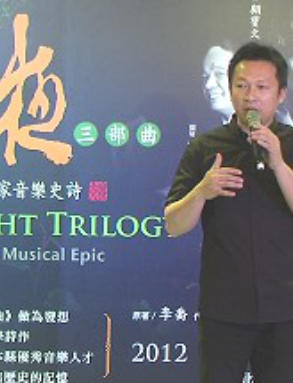

The verse reciter:
Xiong-Huang Jun

The verse creator:


piano soloist:
Rueibin Chen

piano soloist:
Chen-Chien An
Wen-Fang Fam









